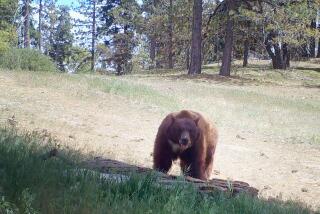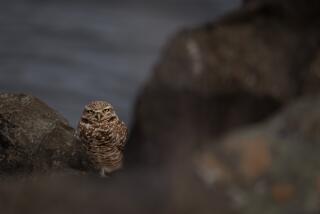Scientists get schooled at Calaveras County frog-jumping contest
Scientists have long thought that bullfrogs generally can’t jump more than a meter. Turns out they were wrong -- which they learned only after leaving the lab and heading to California to witness a county fair contest inspired by one of Mark Twain’s most famous short stories.
These biomechanists didn’t go to the Calaveras County Fair & Jumping Frog Jubilee just to have a good time. The research, published in the Journal of Experimental Biology, shows that sometimes lab studies don’t reveal the full potential of animals’ abilities, and the mechanisms underlying them.
“It’s a cautionary tale to anyone who works with animal behavior and performance,” said David Carrier, a comparative biomechanist at the University of Utah who was not involved in the study.
Laboratory studies of frogs have long found that generally, bullfrogs don’t jump farther than a meter in a single bound. The longest individual leap reported in the lab was 1.295 meters (4.249 feet).
And yet, the Guinness Book of World Records reports that the record belongs to one cleverly named Rosie the Ribeter, who jumped a whopping 2.18 meters (7.15 feet) in a single bound in 1986.
At first, they wondered if these claims were little more than a tall tale -- rather like the one told in Mark Twain’s fictional “The Celebrated Jumping Frog of Calaveras County.”
But then they saw some footage of the frogs’ impressive leaps, egged on by “professional” frog jockeys, in a documentary on the Calaveras County frog-jumping contest. This four-day event outside Angels Camp, Calif., which is more than 80 years old, was actually inspired by Mark Twain’s humorous short story.
They knew they had to check it out.
“It definitely looked like they were really performing exceptionally, and at that point we decided to go to the next fair,” said lead author Henry Astley, a biomechanist at Georgia Tech University.
The frog-jumping contest attracts two types of competitors: layfolk who rent a frog for a few dollars and try their luck and experienced frog jockeys in highly organized teams who have competed for years or decades.
“‘Professional’ frog jockeys bring their own locally-caught frogs and are serious competitors,” the authors wrote, “often working in family groups that have passed down frog jumping secrets through generations of competition.”
The scientists lugged a whole load of lab equipment -- “pretty much everything we could feasibly transport from the lab,” Astley said. But they soon found themselves having to drop their high-tech instruments and improvise in the face of unforeseen challenges.
Though the scientists had brought a force plate -- a tool that takes crucial measurements including jump distances and jump angles -- contest organizers didn’t want any equipment near the frogs as they competed. So the scientists had to rely on a high-speed camera that could take shots of the whole field. They laid down a paper grid in the camera’s field of view so that they’d be able to calibrate the jump measurements later, but the wind kept blowing it away.
Clearly they needed something heavier.
“So we quickly made a run to Home Depot, basically bought out all their PVC pipe and PVC joints and slapped together this enormous rectangular grid,” Astley said. “Every time there was a gap in the performance, we’d just grab the grid, run out there put it down, record a few frames of video, and then take it away so it didn’t disturb anyone.”
After wading through about 15 tapes full of several gigabytes of footage, the true winners became clear: These country frogs blew all those lab frogs’ jumping records out of the water. And it wasn’t an anomaly -- a full 58% of the recorded jumps surpassed the maximum jump distance in the literature, of 1.295 meters. The longest jump was a whopping 2.2 meters -- 70% longer than the lab record.
Why such a vast improvement? The researchers think there are a number of factors at play. Sample size was one of them -- the scientists were able to watch hundreds of frogs on thousands of jumps, compared to the paltry handful they’d do with a few frogs in a lab.
Understanding frog physiology was key: The jockeys would keep the frogs in a cool, dark place before contests, so that they wouldn’t overheat, and then rub their legs to warm them up right before they launch.
But perhaps the most important reason was motivational. The jockeys had specific techniques designed to fully trigger the bullfrogs’ fight-or-flight mechanism: They dropped the frog onto the jump pad from a short height and then lunged after the frog head-first.
In other words, they scared the living daylights out of the antsy amphibian by pretending to try and eat it. These little tips and tricks gained by experience and collected over time seem to make all the difference, the authors said.
The frogs were pushing the limits of what skeletal muscle should physically allow -- and the scientists think that this could possibly be due to tendons in frog legs that can store a lot of potential energy like a bow and arrow and release it all at once, supercharging the frog leaps. Tree frogs take full advantage of this mechanism, jumping from branch to branch -- bullfrogs, not so much.
“So they load energy into tendons and then release that energy to spring off the ground like a slingshot,” said study coauthor Thomas Roberts, a biomechanist at Brown University. “Because of the relatively lackluster performance we got out of bullfrogs, we thought this mechanism wasn’t really well developed in bullfrogs.”
They figured that the bullfrogs had traded in this ability for stiffer tendons in their legs, which were more adapted to swimming than springing. But perhaps -- with the right motivation -- this mechanism could still kick in.
“Those kinds of jumps just can’t be produced by muscle power alone,” Roberts said.
After studying 3,124 jumps, they saw that there was a sharp drop in the number of jumps exceeding 1.9 meters (6.2 feet) -- a sign that they were approaching a physical limit to how far they could leap. And pinning down that maximum ability is crucial to understanding how evolution drives those physical traits, said Andrew Biewener, a biomechanist and deputy editor in chief of the Journal of Experimental Biology.
“We’re often interested in maximum performance because we think natural selection might often operate on performance limits,” Biewener said.
The work is also a testament to what scientists can learn from the professionals, Carrier added.
Often, he said, “scientists don’t take the time -- or there’s too much arrogance -- to go to people who actually have years and years, lifetimes of experience working with animals. These practitioners, particularly when you’re talking about animal behavior, have a lot to teach us.”
The scientists even tried their hand at frog-jumping while at the jubilee, Astley said. They couldn’t touch the pros.







